Click here to print
Jason Curtis: A Librarian Who Collects Media Formats
posted May 25, 2018
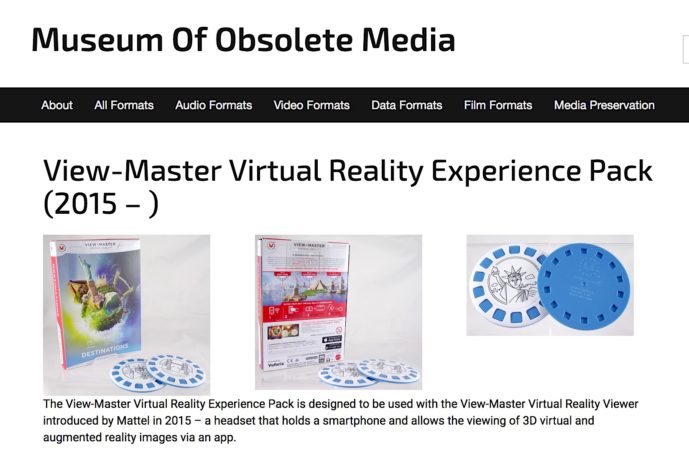
After working with many media formats that disappeared from use, Jason Curtis decided to start collecting examples of those dodos of audiovisual and computer technology.
Inevitably, collecting introduced him to more and more formats that he had never used, nor in many cases ever heard of, and he began gathering examples of those, too.
Now he has examples of hundreds of media formats. “The urge grew to collect all of them,” he says — as any collector knows it will.
He says undertaking to build his collection was “just personal interest, really — thinking about formats disappearing that I’d used in the past or formats I was aware of that were once quite common and were no longer around, like floppy discs, that disappeared quite quickly.”
He started modestly, he recalls: “I really only thought in terms of a few formats; I never thought it would expand up to now past 500.”
Since his university days, he has worked as a medical librarian. His collection, he says, “is really completely out of my normal working field.”
But his work helped to make him alert to the nature of collecting, and need for it: “Many of the formats I had grown up with, such as video tapes, music cassettes, and floppy discs were quickly disappearing, sometimes to be replaced by other formats, but increasingly with no physical format at all, as content is increasingly delivered over the Internet.”
Where to Store It All?
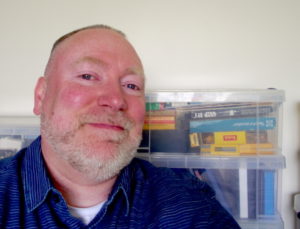
Eventually he needed somewhere to put everything he was saving, and some way to share it with whoever else might be interested.
The result since 2013 has been his Museum of Obsolete Media, an online museum housed at his home in Shropshire, in rural England near the border with Wales. There, he displays at least one example of each media format, whether audio, video, or data storage.
He displays information about each, when he can; in some cases that amounts to little if any. He says: “There probably is a lot of information around if I had the time to dig, I suppose — things like company archives, or people who worked with the formats or designed them in the first place. I tend to rely on what I can easily track down on the Web.
“There will be some formats where there’s no academic literature on it, or the people who were involved have moved on, or things have come and gone, or if they were proprietary to a particularly company they might not have published information.”
As a librarian by profession, Curtis says, he wanted a means to organize the collection, to document it properly, and to make it discoverable in different ways, through lists, images, tags, and so on. Making the Museum a website institution, as he did in 2013, “allowed me to do this both to satisfy my own desire for order, but also to satisfy a sense of responsibility I felt, having collected so many formats including some unusual and rare exhibits, to share the collection with the wider world.”
Expanding Criteria

Eventually Curtis decided he would also collect media formats that seemed likely to become obsolete, soon or eventually. Those may be interesting to collect and document due to their particular compelling histories; they may, for example, have seen off a succession of competitors. “In addition, he says, “many of these formats have spawned variants,” and that illustrates the nature of format innovation.
As a simple example with which many people are at least partly familiar, he cites the 12-inch LP record, which not long ago appeared bound for the graveyard of technologies, but that now is off life support and looking quite hale. And during its life, Curtis notes, the 12-inch LP has had such spin-offs as 10-inch LPs, laser-etched LPs, CD-4 quadraphonic, and dbx discs. So the progenitor of all those dead or dying formats needs to be in the Museum, itself.
More commonly, of course, many a fit-as-a-fiddle format of today is tomorrow’s bone in a graveyard. “There are many formats in the collection that were current when I started collecting in 2006 that are now obsolete,” Curtis notes. In fact, some formats that were introduced after he began collecting have already disappeared. “Rather than wait for them to become obsolete, I feel it is worth collecting them now while they are easily available,” he says.
He also collects information about how to preserve still-current formats, reasoning that while not yet obsolete, some — early CD-RWs, for example —already experience deterioration and data loss.
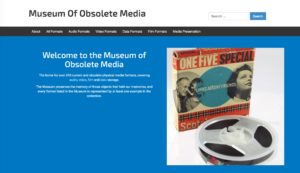 Originally he didn’t intend to collect film formats, but that changed. Mind, he can’t altogether remember how that came about. “I think,” he says, “my original intention was to collect removable formats: things you put into a machine, like a video tape or an audio tape, and use again and again, whereas with things like, say, a film cartridge, you’d use it once, and that was the end of it, really; you’d take out the film and then the cartridge would be disposed of.”
Originally he didn’t intend to collect film formats, but that changed. Mind, he can’t altogether remember how that came about. “I think,” he says, “my original intention was to collect removable formats: things you put into a machine, like a video tape or an audio tape, and use again and again, whereas with things like, say, a film cartridge, you’d use it once, and that was the end of it, really; you’d take out the film and then the cartridge would be disposed of.”
Thinking about the issue some more, he adds: “I realized quite quickly that not everything fits into a nice category, and I also had got to the point where I had collected quite a lot of the other formats, and I was finding it harder to find new things, and thought it would be interesting to move into film. And, again, having used things like instamatic cameras when I was young, I thought it would be interesting to have examples of that kind of thing, as well.”
A Potentially Expensive Hobby
He recalls, too, that he had hesitated to wade into collecting film formats in part because he knew that could be expensive. “Particularly for motion pictures, I wasn’t sure how easy it would be to come across stuff, out there,” he says.
“There are dozens of motion-picture formats that I haven’t got,” he says. “It’s a vast area, but it’s still one I’d like to carry on doing.”
Over all, his can be a relatively expensive hobby, but it doesn’t send him to the poorhouse: “It’s not cheap but it’s sustainable, and I try not to spend too much each month. For me, it’s just a hobby and I’m happy to spend some money on it. There are things I would like to buy that are very expensive – certain formats that are very rare or expensive. They’ll have to wait.”
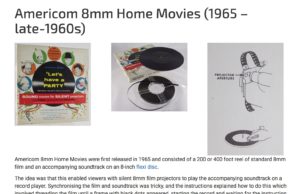 Like? “The next thing I would like to get is some phonograph concert cylinders —the large-diameter cylinders like Edison and Columbia made, and they’re very expensive, and the post and packing is, as well, because they’re almost always in the States. They’re on my ‘wants’ list and I will have to splash out on them, eventually.”
Like? “The next thing I would like to get is some phonograph concert cylinders —the large-diameter cylinders like Edison and Columbia made, and they’re very expensive, and the post and packing is, as well, because they’re almost always in the States. They’re on my ‘wants’ list and I will have to splash out on them, eventually.”
“And there are a few more-modern film formats like disc-cartridge systems, and memory cards of video cameras which I will eventually get hold of, but again, at the moment they’re very expensive. They’re quite current, I suppose, and have a large capacity.”
He doesn’t collect equipment and devices needed to use the media formats. That’s largely due to space and cost limitations. With more than 500 formats in his collection, he says, “I would probably need around 300 or more devices to use them all.” He has bought many items (on eBay, largely, but some from antique shops) and been given others. That makes it possible to use some of the formats he has collected, or to serve as props in photographs, and he occasionally has had to buy a device as a way to obtain the media format he was seeking.
But collecting devices… Down that road may lie penury. So far, Curtis says, he hasn’t been tempted. (He has posted a notice on his site: “I’m unable to accept offers of media players due to space, but if you have any audio players, Andy Vizor at AVAV Systems may be able to offer them a home.” He has quite a good collection of audio equipment, and has been a major donor to Curtis’s museum; Curtis has donated items to Vizor, as well.)
Curtis has received some items as donations. “Because I have a Twitter feed now from the Museum, I do get people contacting me through that, and through the website, as well, with donations. And I’ve been very fortunate to have some useful items donated that I would never have found, otherwise.”
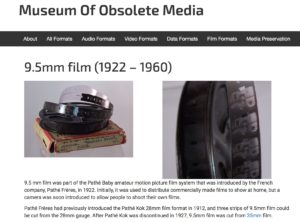 Of course his collection will never be complete. “The more I collect, the more formats or variations of formats I discover,” he says, echoing many a collector’s experience. In fact, he says, “my ‘wanted’ list never seems to get any smaller.” Rather, it become “more difficult and expensive to source items.” Still, he says, “many items that I never thought I’d obtain have cropped up, so I hope to carry on as long as I can.”
Of course his collection will never be complete. “The more I collect, the more formats or variations of formats I discover,” he says, echoing many a collector’s experience. In fact, he says, “my ‘wanted’ list never seems to get any smaller.” Rather, it become “more difficult and expensive to source items.” Still, he says, “many items that I never thought I’d obtain have cropped up, so I hope to carry on as long as I can.”
As Curtis puts it, his museum preserves the memory of objects that have held our memories.
— Peter Monaghan
Motion Picture and Video Formats on Jason Curtis’s Wanted List
If you have any of these, Jason Curtis at the Museum of Obsolete Media would like to hear from you.
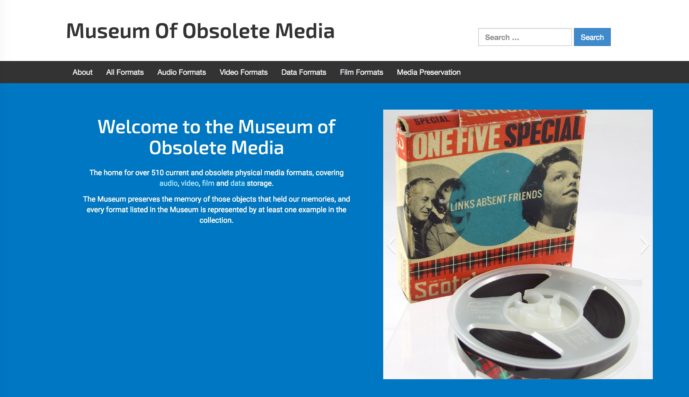
Motion Picture
- Kinora reel
- Super 16
- Fairchild Moviepak Seventy Cartridges
- Paper prints of films
- Bell & Howell Filmosound
- Vitaphone (motion-picture sound-system transcription disc)
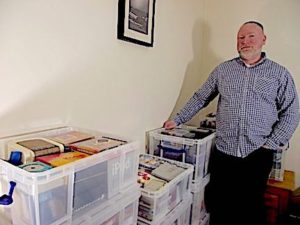 Video
Video
- 2-inch Quad / Quadruplex
- Akai VK
- Akai ¼-inch tape on 10.5-inch reel for VT700
- Pre-recorded S-VHS
- W-VHS
- miniDVD (cDVD)
- M
- Panasonic D3
- Philips D6
- DVCPRO50
- DVCPRO HD
- HDCAM (S size)
- HDCAM SR (S size)
- DVDplus
- MUSE HI-Vision LD
- Super Video CD (SVCD)
- Sony AXS card
- Panasonic P2 card
- Sony SR Memory
Printed from Moving Image Archive News: https://www.movingimagearchivenews.org
URL to article: https://www.movingimagearchivenews.org/museumofobsoletemedia/
Click here to print